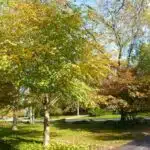As a botanist and gardener, I’m often asked about fast-growing shade trees. Shade trees provide beauty and cooling relief to any yard, but many people want to enjoy these benefits without having to wait years for their trees to reach full maturity. That’s why the topic of fast-growing shade trees is so important – it allows people to experience the joys of having a shady and beautiful backyard much sooner than otherwise possible.
In this article, I will discuss 7 types of fast-growing shade trees that are ideal for planting in zones 5–10. All of these species have distinct characteristics that make them perfect for providing shade in any climate. I will also provide information on how best to care for each tree, including tips on soil preparation, fertilizer use, and pruning techniques.
Finally, I will provide an overview of the common pests that tend to affect these species and offer advice on how to prevent or manage these issues. With my help, you’ll be able to choose the right fast-growing shade tree for your yard and ensure that it thrives in its new environment!
Types Of Shade Trees
Shade trees are an essential part of landscaping, providing not only a visual break from the stress and intensity of urban life, but also offering much-needed shade on hot summer days. There are many types of fast-growing shade trees that gardeners can choose from, depending on their unique needs and climate. In this article, we’ll look at some of the most popular varieties available.
The first type is the Bald Cypress, a deciduous tree that grows quickly and produces an umbrella-like canopy for deep shade. It’s native to wetlands throughout the eastern U.S., making it an excellent choice for gardens with wet soil and areas prone to flooding. The second type is the Eastern Redbud, which has a beautiful spring flower display and can grow up to 30 feet tall in full sun or partial shade. This tree is often used as a focal point in landscape design due to its vibrant colors and unique form.
Finally, there’s the Northern Catalpa Tree, which is known for its large leaves and showy clusters of white flowers in late spring. This tree grows best in full sun but can tolerate partial shade as well. It’s also tolerant of drought conditions and poor soils, making it ideal for those with limited gardening space or soil quality issues.
Many gardeners find that fast-growing shade trees offer numerous benefits when incorporated into a landscape plan. They provide ample coverage from sun and wind while still allowing light through their branches; they are low maintenance; and they can add beauty all year round with their colorful foliage or blooms in springtime. With so many benefits to consider, these trees are definitely worth looking into for your next landscaping project!
Benefits Of Fast-Growing Shade Trees
The benefits of fast-growing shade trees are like a breath of fresh air. With their towering presence and lush foliage, they can provide a cool and calming atmosphere for any outdoor space. As specialists in botany and gardening, we recognize how beneficial these trees can be to the environment and those who enjoy it.
One of the most important advantages of fast-growing shade trees is their ability to quickly improve the aesthetics of an area. Not only do they add a beautiful touch to your landscape, but they also bring a sense of peace and tranquility. In addition, these trees can shield you from harmful UV rays, making them perfect for providing relief during those hot summer days.
Furthermore, these trees are incredibly resilient; they’re able to withstand strong winds, heavy rains, and even extreme temperatures with little maintenance required. This means that not only are you getting a gorgeous tree that looks great for years to come; you’ll also be saving time by not having to constantly care for it!
With all these advantages in mind, selecting the right shade tree can be straightforward if you know what features you’re looking for – such as size, shape, texture – that will best suit your property’s climate and other specific needs.
Selecting The Right Shade Tree
When selecting a fast-growing shade tree, there are a few important factors to consider. As an expert in botany and gardening, I recommend the following guidelines to ensure success in your project.
First, determine the size of the area where you want to plant your tree. This will help you select a tree that is appropriate for both the space and its intended purpose. For example, if you are looking for a tree that will provide ample shade in a small patio area, then you may want to choose a smaller variety such as an Ornamental Pear Tree.
Second, consider the climate of your location. Fast-growing shade trees thrive best in moderate climates with plenty of sunlight and adequate rainfall. If your location experiences extreme temperatures or drought conditions, then be sure to choose one of the many hardy varieties available for planting in these areas.
Third, it’s important to be aware of any local ordinances that may restrict what type or size of tree can be planted on your property. Many cities have regulations that limit homeowners from planting certain species due to their potential invasive nature or height restrictions that must be followed when planting near power lines or other structures. Be sure to check with your local municipality before selecting a tree in order to avoid any unnecessary fines or complications down the road.
With these considerations in mind, you’ll be well on your way towards choosing the perfect fast-growing shade tree for your yard! Now let’s take a closer look at one popular option – the Ginkgo Tree – and learn more about its characteristics and benefits.
Ginkgo
The Ginkgo tree is the perfect choice for those looking to add a fast-growing shade tree to their garden or lawn. This species of tree is both hardy and beautiful, offering lush green foliage in spring and gorgeous golden hues in fall. It can grow up to 5 feet per year, making it an ideal choice for those who need a quick-growing solution for providing shade. Here are some key points about Ginkgo trees:
• They can reach heights of 30-80 feet tall within 10 years of planting. • They are extremely drought tolerant and require little maintenance once established. • The bark is smooth and gray with distinctive diamond shapes. • They have fan-shaped leaves that turn stunning shades of yellow in the fall.
Ginkgo trees are relatively low maintenance, making them a great choice for busy gardeners or those without experience caring for trees. They are also resistant to disease and pests, so they require minimal upkeep. Additionally, they’re tolerant of poor soil conditions, such as compacted soils or those with low fertility levels. As a result, they’re very easy to maintain over time and will continue to provide shade throughout the years with minimal effort on your part.
Ginkgo trees are also incredibly versatile when it comes to placement in your landscape design plan. Whether you want a large canopy tree or a smaller specimen tree, these fast-growing options can be planted almost anywhere you need them – from large front yards to narrow backyards or along walkways or driveways. With their unique shape and bright foliage, Ginkgos make an excellent addition to any type of garden setting that needs some extra shade coverage quickly.
Whether you’re looking for an attractive specimen tree or just need some extra shade coverage in your yard, Ginkgo could be the perfect solution for you! With its easy maintenance requirements and stunning seasonal colors, this fast-growing tree is sure to bring beauty and function to any outdoor space it occupies – all while providing much needed shade in no time at all!
Tulip Tree
The Tulip Tree is a majestic beauty that can be seen gracing the gardens of many. Like an elegant sculpture, it towers over its surroundings with an air of grandeur and sophistication. Its presence can bring life to any outdoor space, providing a sense of calm and lushness.
A fast-growing shade tree for zones 5-10, the Tulip Tree is perfect for homeowners looking to quickly create a shady environment in their garden or yard. Its leaves are broad and lobed with distinct notches, while its bark has a reddish-brown hue that becomes scaly with age. In the spring months, its tulip-shaped flowers bloom in shades of yellow and green and have a pleasant scent.
Tulip Trees are also known for their durability and resistance to diseases. Given proper maintenance, they can easily reach heights of up to 80 feet tall and live for decades! For those looking to add variety to their landscape, this tree pairs well with other species such as maple, oak or river birch trees.
River Birch
Juxtapose the fast-growing river birch tree with its slow-growing counterparts. This deciduous tree is a great choice for providing shade in a short amount of time! River birch can grow up to two feet per year, making it an attractive option for those who want to enjoy a shady spot in the garden quickly.
River birch is well suited for zones 5 through 10. It’s tolerant of wet soils, so it’s ideal for areas of high rainfall or near water sources like ponds, creeks, and streams. Its bark is particularly attractive—it peels off in thin layers that curl back from the trunk and limbs, revealing patches of creamy white inner bark.
When planted in full sun, this fast-growing tree will produce beautiful yellowish-green catkins (flower clusters) from April to May. These trees are also known for their tolerance to air pollution and drought—perfect for those living in urban areas! Additionally, its foliage provides cover for wildlife and birds during the summer months.
River birch offers plenty of benefits with minimal effort: its rapid growth rate provides quick shade and its resilience makes it easy to maintain even in challenging climates!
Red Maple
A diamond in the rough, Red Maple is an ideal tree for those who are looking to add a bit of shade to their gardens in no time. This fast-growing species is a perfect choice for gardeners living in Zones 5 through 10 who want to enjoy the beauty of the outdoors without having to wait years and years for it.
Native to North America, this deciduous tree can grow up to 70 feet tall, and its leaves come in a range of colors from yellow, orange, and red that adds a lovely touch during fall season. Red Maple does well in both wet and dry soils, but it needs full sun exposure for best results.
In terms of maintenance, pruning should be done regularly as this tree grows quickly and may begin to outgrow its space if left unchecked. While it’s not particularly vulnerable to pests or diseases like other trees, it’s important to keep an eye out for any potential issues that may arise with your Red Maple. With proper care and attention, this reliable species can provide years of joy!
American Hornbeam
American hornbeam, also known as Blue Beech or Ironwood, is a fast-growing shade tree that can provide relief from the sun in hot summer months. It’s an ideal choice for many gardens because of its distinctive fluted trunk and stunning autumn foliage. As an added bonus, it is also one of the most drought tolerant trees available.
This hardy variety is native to the eastern United States and Canada and can reach heights of up to 40 feet with a canopy width of 25 feet when fully grown. It prefers full sun to partial shade and has moderate water requirements once established. The American hornbeam is also relatively tolerant of urban conditions such as air pollution and salt spray, making it a great choice for city landscapes.
In terms of maintenance, American hornbeam requires little pruning due to its slow growth rate; however, it is important to remove any dead or diseased branches right away. Additionally, this tree produces small fruits that may attract birds, so gardeners should take care to keep their property clean and tidy if they choose this species for their landscape design. With proper care, American hornbeam will thrive in sunny spots in your garden for years to come.
Siberian Elm
The Siberian Elm tree is an urban oasis, offering shelter and shade in even the most built-up of environments. Its fast growth rate means that its canopy can be established quickly and its roots will become firmly rooted in the ground with minimal disturbance. This hardy species has been known to survive temperatures as low as -40°C (-40°F), making it an ideal choice for colder climates. Its bark is dark grey and its leaf shape is oblong, with a point at one end and a serrated edge at the other. It is tolerant of drought, pollution, wind, salt spray and compacted soil, making it one of the toughest trees available for landscaping projects.
This deciduous tree will thrive in full sun or partial shade and prefers moist but well-drained soils. In springtime it produces clusters of small yellow flowers followed by winged fruits which are attractive to birds. The Siberian Elm can quickly reach heights of up to 40 feet (12 m) with a spread of about 20 feet (6 m). Pruning should be done in late winter or early spring before new growth begins to ensure that a desirable shape is maintained.
The Siberian Elm provides an excellent source of shade for gardens large and small, as well as street trees in city parks or boulevards. Its overall toughness makes it ideal for the novice gardener who may not have access to the resources needed to maintain more fragile species. For those looking for fast results without compromising on quality, this tough tree is hard to beat!
Hackberry
The hackberry tree is a behemoth among shade trees, rising like a giant from the earth. Its dense foliage blocks out the sun’s rays like an umbrella, providing shelter not just for those underneath but also for many creatures that make it their home. As a fast-growing tree, the hackberry will quickly expand to its full height of 30 to 60 feet within its first 10 years, making it an ideal choice for homeowners seeking to create a grand canopy of protection over their property.
When it comes to hardiness and resilience, the hackberry stands firm against insects and disease. It also tolerates alkaline soil better than most other trees and is generally more drought-resistant than its deciduous counterparts. As far as aesthetics go, this tree’s bark ranges in color from greenish-gray to reddish-brown with corky ridges that give it a unique texture. Its leaves are oval in shape and light green in color during summer months; in winter they become yellow before falling off.
Hackberries produce small fruits which can be eaten by birds and other wildlife, though they should not be consumed by humans under any circumstances as they contain toxins. The long-term success of any planting depends on choosing species that are adapted to local conditions—and when it comes to shade trees, the hackberry is an excellent option for zones 5–10 due to its hardiness and quick growth rate.
Northern Red Oak
The northern red oak, also known as Quercus rubra, is a robust and hardy tree species that can bring a great deal of shade to any space. These trees are quite fast-growing, reaching up to two feet in height annually. The northern red oak is best suited for growing in zones 5–10, where the soil is moist but well-drained.
This majestic evergreen tree provides plenty of benefits to those who choose it for their landscape. Here are four reasons why the northern red oak is an ideal choice: • It provides dense shade throughout the year • Its leaves are an attractive dark green color with a glossy finish • It’s highly resistant to drought conditions • It’s been proven to be strong enough to withstand high winds and other extreme weather conditions.
The northern red oak can also provide additional beauty and texture to any garden or outdoor space with its unique bark texture and bright yellow autumn foliage. This tree is a reliable source of shade and beauty for years to come, making it an excellent choice for any gardener or landscaper looking for fast-growing coverage. Transitioning seamlessly into the next section about white oaks, this species offers an abundance of advantages that should not be overlooked.
White Oak
Coincidentally, the next tree on the list of fast-growing shade trees is the white oak. This species is perfect for anyone looking for a hardy and adaptable tree that can provide plenty of shade in no time. As a botanist and gardener, I believe that this tree should be considered by anyone seeking to add some greenery to their property.
White oaks are an incredibly attractive species with beautiful leaves and bark, making them an excellent addition to any landscape. They are also very tough and durable, able to withstand strong winds and snow storms without much damage. Furthermore, they grow at a rapid rate, often reaching heights of up to 40 feet within 10 years. As such, these trees provide quick coverage for those who need it most.
In terms of maintenance, white oaks don’t require too much attention from the gardener or homeowner. They only need occasional pruning to keep their branches from becoming too dense or overcrowded. Additionally, they thrive in many soil types and require minimal watering during dry spells. All in all, they are an ideal choice for anyone looking for a fast-growing shade tree that won’t require much upkeep over time. With its combination of beauty and reliability, the white oak is a great pick for anyone seeking some extra shade in their yard.
Black Walnut
The majestic Black Walnut tree is a sight to behold. Its tall, straight trunk stands proud and its thick canopy of glossy green leaves provides a lush shade that is nothing short of luxurious. It’s the kind of tree that you could sit beneath in the summer and feel like you were transported to a different era – one of mystery and grandeur.
As a fast-growing shade tree, the Black Walnut can grow up to three feet per year. This makes it an ideal choice for those looking for quick coverage in their yard or garden. Unlike other common varieties, this species has the added benefit of being extremely hardy and tolerant of many types of soil and climate conditions.
In addition to providing ample coverage, the Black Walnut has some interesting characteristics which make it stand out from other trees. The walnuts themselves are edible, making it an excellent choice for those wanting to create an edible landscape. The bark also has unique ridges and brown furrows which add a great visual contrast against the glossy green leaves.
This beautiful shade tree is sure to be an attractive addition to any outdoor space! With its fast growth rate and unique characteristics, it’s no wonder why the Black Walnut is becoming increasingly popular amongst gardeners and landscapers alike.
Chinese Fringetree
The Chinese Fringetree is nothing short of a miracle for any gardener seeking to create a fast-growing shade tree. It’s growth is absolutely astonishing – almost too good to be true! This magnificent tree can give you the shade you need in no time flat, and its beauty will surely captivate your guests. Here are just some of the amazing benefits of planting this extraordinary tree:
• It reaches an average height of 20-30 feet tall, making it an ideal choice for creating shade quickly. • Its bright white blooms in spring and yellow foliage in the fall make it a stunning addition to any landscape. • The fringetree has an impressively long lifespan, with some specimens living up to 200 years old. • It can tolerate a wide range of soils and climates, making it easy to grow in many locations.
For botanists and gardeners alike, the Chinese Fringetree is an excellent choice for creating a shady area with minimal effort or maintenance. Its fast growth rate makes it ideal for those looking for quick results, while its beauty ensures that the results will last for years to come. With so much to offer, this remarkable tree should be on anyone’s list when looking for a fast-growing shade tree. Transitioning seamlessly into Zelkova trees…
Zelkova
Welcome to the world of gardening! Today, we will delve into the wonders of Zelkova trees. This fast-growing shade tree is a great choice for those looking to create a beautiful landscape and provide some much-needed respite from the sun.
Known as one of the most resilient trees, the Zelkova is able to survive in even the harshest climate conditions. Its waxy leaves and smooth bark make it an ideal choice for those wanting to add a unique look to their outdoor space. Moreover, it is incredibly quick growing, with some specimens reaching heights of up to 50 feet within just five years!
Not only are these majestic trees attractive and hardy, they also offer numerous benefits: they can absorb pollutants from the air, reduce wind speed in urban areas, and help protect against erosion. With all these features combined, it’s no surprise that the Zelkova has become one of the most popular fast-growing shade trees among gardeners everywhere!
Whether you’re looking to create a relaxing oasis in your backyard or simply want to bring a bit of nature into your home, consider adding a Zelkova tree – you won’t regret it!
Frequently Asked Questions
What Is The Best Way To Care For Fast-Growing Shade Trees?
When it comes to caring for fast-growing shade trees, the key lies in understanding their needs and providing them with the right environment. As a specialist in botany and gardening, I know that there are a few simple steps you can take to ensure your trees stay healthy and lush – all while providing much-needed shade during hot summer days.
Firstly, keep an eye on soil moisture levels. Fast-growing shade trees require regular watering throughout the growing season, but they don’t like soggy soil or standing water. When planting, create a shallow berm around the tree to help retain moisture. Additionally, mulch around the base of the tree helps to maintain soil moisture levels and reduce weeds.
To provide added protection for your shade trees from harsh weather conditions, prune them regularly. Pruning encourages growth and helps promote a healthier canopy of foliage. Pruning also helps reduce stress on weaker branches that may be susceptible to storm damage or disease. For best results: • Prune in late winter when the tree is dormant; • Remove any deadwood; • Thin out overcrowded branches; • Trim back any vigorous shoots that are taking over ; and • Cut back long stems that could be damaged in strong winds.
Finally, make sure your fast-growing shade trees receive adequate nutrients by fertilizing them twice a year – once in early spring and again in late fall after leaf drop has occurred. Choose an organic fertilizer with good nitrogen content and follow the manufacturer’s instructions carefully when applying it around the base of the tree. With just these few steps taken care of, you can rest assured that your fast-growing shade trees will thrive for many years to come!
How Quickly Do Fast-Growing Shade Trees Reach Full Size?
Have you ever wondered how fast fast-growing shade trees can reach full size? It’s a common question among botany and gardening specialists, especially those looking to create a lush, green environment in their backyard. With the right care, these trees can grow to their full potential in no time. Let’s explore the growth rate of some popular fast-growing shade trees:
Firstly, there are the hybrid poplars, which are well known for their rapid growth rate. In optimal conditions, they can grow up to ten feet per year! Secondly, willow trees are incredibly adaptive and often reach heights of up to 50 feet within just 10 years. And lastly, maple trees have an impressive spread of up to 40 feet when grown from seedlings.
When it comes to taking care of fast-growing shade trees, proper watering is crucial for encouraging new growth. The soil should be kept moist but not waterlogged – too much water can easily lead to root rot and other diseases. Pruning is also necessary for controlling size and shape; this should be done during late winter or early spring when the tree is still dormant. To ensure healthy growth and maximum potential, fertilization every two months is recommended throughout the growing season.
By taking these simple steps into consideration while tending your fast-growing shade tree, you’re sure to be rewarded with a dense canopy in no time at all!
Are Fast-Growing Shade Trees Suitable For Small Gardens?
Are fast-growing shade trees really suitable for small gardens? This question has been the source of much debate among gardeners and botanists. Well, I’m here to set the record straight. After years of research into horticulture, I can finally tell you that yes, fast-growing shade trees are indeed perfect for small gardens.
Let me start by saying that this isn’t just a matter of opinion – there’s a wealth of scientific evidence to support my claim. Studies show that these trees are easy to maintain and don’t require as much upkeep as other types of trees. Furthermore, they often reach full size within two or three years – so you get a lot more bang for your buck! This makes them ideal for people who want to add some greenery to their outdoor space without having to wait decades for their tree to grow.
But it doesn’t end there. Fast-growing shade trees also provide numerous benefits, such as helping to reduce air pollution and providing wildlife habitats. Not only will your garden look beautiful, but you’ll also be doing your bit for the environment! So if you’re looking for a way to spruce up your outdoor area while still being mindful of the planet, these trees are an excellent choice.
Are Fast-Growing Shade Trees More Prone To Disease Than Other Types Of Trees?
When it comes to selecting the right type of tree for your garden, there are a variety of factors to consider. One such factor is disease resistance, as some types of trees are more prone to diseases than others. This article will explore whether fast-growing shade trees are more prone to diseases than other varieties.
Generally speaking, fast-growing shade trees tend not to be as resistant to disease as slower growing varieties. This is because these trees have less time for their root systems and foliage to become established, making them more susceptible to fungal and bacterial infections. In addition, these trees may have an increased need for fertilizer and water, which can lead to deficiencies that can also make them more susceptible to disease.
However, it is important to note that there are certain types of fast-growing shade trees that can be just as resistant or even more resistant than slower growing varieties when properly cared for. The key is in selecting the right species according to the specific climate and soil conditions in your area and ensuring that you provide adequate care and nutrition for your tree throughout its life cycle. With proper care and attention, fast-growing shade trees can thrive in any garden setting despite their increased susceptibility to disease.
Can Fast-Growing Shade Trees Be Used To Create A Windbreak?
Creating a windbreak with fast-growing shade trees can be an effective way to protect your property from harsh winds and the elements. Fast-growing varieties of trees are ideal for providing quick, long-lasting coverage that can help reduce wind damage to structures, plants, and other landscape features. Here are three key things to consider when deciding which type of fast-growing tree is best for your windbreak:
- Consider the size of the tree you choose – depending on the area where you plan to use it, you may need a large or small variety. Taller species may be better suited for larger properties while smaller trees may be preferable when space is limited.
- Look at the growth rate – most fast-growing trees have a rapid growth rate that will provide protection within a couple of years. However, some species grow faster than others and in different climates, so research what type of growth rate and climate works best for your needs.
- Evaluate the tree’s hardiness – make sure to select varieties that are suitable for your local climate conditions and that can withstand strong winds year-round. Some fast-growing species may not be as sturdy as others and may require more maintenance over time.
As a specialist in botany and gardening, I recommend researching various types of fast-growing shade trees before making your decision. Once you’ve identified which species works best for your specific situation, it’s important to properly plant and maintain your tree so that it will thrive in its new home and provide suitable protection against harsh winds year after year. Taking these steps will ensure that you have an effective windbreak while also enjoying all the benefits these beautiful trees have to offer!
Conclusion
Fast-growing shade trees are a great choice for landscapers looking to create a shady spot in their yard in the shortest amount of time. They come with their own set of considerations, such as how quickly they reach full size and whether or not they can be used to create a windbreak. With proper care and attention, these trees can be a beautiful part of any garden, providing lush foliage and welcome shade on hot summer days.
For those seeking an instant solution to the quest for shade, fast-growing trees can be likened to a gift from nature’s own hand; providing quick results with minimal effort. That being said, it is important to remember that these trees will still require some maintenance in order to stay healthy and vigorous over the long term. Regular pruning and routine fertilization will help keep them looking their best.
In conclusion, fast-growing shade trees provide an effective solution to those who need quick results when it comes to creating shaded areas in their yards or gardens. With thoughtful selection and careful tending, these trees can become a living work of art that provides beauty and solace now and for years to come.





























